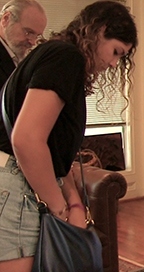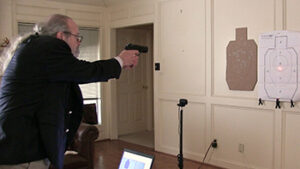Why you should consider using realistic targets as part of your personal defense weapons training
Training the brain.
By: Ed Hardin (Certified NRA firearms instructor) for iFightBack (Self-Defense Software for home or classroom)


What difference should it make to be shooting one type of target or another when it comes to defensive firearms training? ( as opposed to “target practice”)
Learn to act without thinking about each step!
One of the key aspects of many types of training is building “muscle memory”. For shooting, muscle memory normally means teaching your body to perform grip, trigger control, sight acquisition, etc. automatically when needed. They call it “muscle memory” but what you are really doing is creating pathways in your brain to connect certain areas of memory directly to the muscles needed to reenact that memory, bypassing any analytical processes. In other words, you can just do it without having the think about each step it takes to accomplish the task.
Be mentally prepared for the worst!
Besides muscles, however, there are other aspects that come into play during an encounter where deadly force may be needed. Other than psychopaths, we all have (or should have) an ingrained emotional aversion to taking another life. That aversion will come to the fore in the event that the need to use deadly force ever arises. Because using deadly force crosses this aversion threshold, even the police will require any officer involved in a deadly encounter to submit to counseling. The overwhelming majority of us will have this aversion to taking another life, even if it is a justified use of deadly force.
When the worst comes,
…be prepared to act instinctively!
This natural aversion might cause you to pause for a critical second or two while your brain stops to resolve your conflicted emotions. This pause could prove to be fatal…to you. Don’t get me wrong. I am not advocating that you train yourself not to care about taking another life. I do not want you to become an armed psychopath. I am advocating that, when adrenaline is telling you that you or your loved ones are in immediate mortal danger, your brain has been trained to not hesitate and to react accordingly.
Where do I know that guy from?
So how does one train for this? Your brain is a series of connected pathways. This is connected to that and that is connected to this other thing and so on. Just like when you know someone from church, for example. You see him there every Sunday and recognize him. All of a sudden, by chance, you see him at a football game. You know he looks familiar but you cannot quit place him. He is out of context. The connection between him and church has been established in your brain but not between him and football and so it takes you a second or two to recall where you know him from.
Wait a minute…this isn’t the range!
And so it is with targets and shooting. To always shoot at round bullseye or flat silhouette targets creates a association in your brain between pulling a trigger and this type of target. To have something out of context all of a sudden in front of you when you need to pull the trigger to save your life or that of another may cause you to hesitate briefly while your brain makes the necessary connections to what is going on with what you need to do.
No zombies allowed.
For what it is worth, the private shooting club that I belong to here in Texas does not allow the use of any target representing a human, even in zombie form. I believe that what they are trying to avoid is the use of realistic targets depicting media personalities, politicians, minority groups, etc. That could lead to a heated argument between you with a gun and the guy next to you with a gun. Which is what this rule, at our gun club, is trying to avoid. If your favorite shooting range does not allow realistic targets, dry-fire practice outside of the range would be very useful. See article Drawing From Concealment: Dangers to Yourself and Others and how to avoid them.
Click here for a YouTube demo video of dry fire practice.
(No realistic targets in the demo but you will get the idea)
Choose your targets to reflect the real world.
This brings me to one last point. Keep in mind when selecting realistic targets to not bring your personal stereotypes into the selection process. In real life bad guys (male or female) can be any age, any ethnicity, any nationality and can be carrying any weapon such as a bat, knife, gun, etc. To train with only one type of realistic target defeats the purpose of using realistic targets in the first place. If you train with a target of an attacker that is always one gender, one age, one ethnicity, and/or one nationality, then you are training your brain to build that connection. Then, if you are ever unfortunate enough to be attacked, chances are it will probably not be someone who fits your particular stereotypical view. And then your brain will have to pause while it connects the dots between what you feared might happen and what is actually happening. Mix up your targets….
Simulation based software takes this up a notch.
Granted, a realistic target is still a paper target but, visually, to the brain, it is closer to what a real threat will look like than a bullseye target. Closer still is an actual interactive video as used in software such as our iFightBack® firearms training software. Here is an example of that type of interactive simulation based video Click to view YouTube example

Train as if your life depended on it.
Training is vitally important. Don’t get lulled into believing that just because you have a gun in your house and/or in your holster or purse that you are prepared to defend yourself and your family. When an attack happens and the adrenaline hits, without training, you will be flopping around like a fish out of water trying to get your brain and body coordinated and into action. This is when muscle memory of both the body and the mind needs to take over.
At SelfDefenseSoftware (developers of iFightBack) our motto is “Practice as if your life depended on it!” We advise that you take advantage of more than one training and practice method.
5/6/2019






 Optionally, the
Optionally, the 
